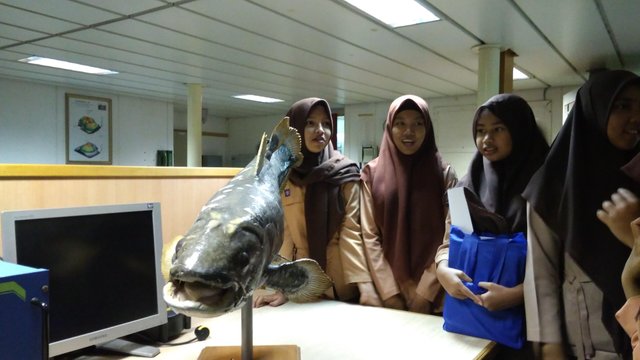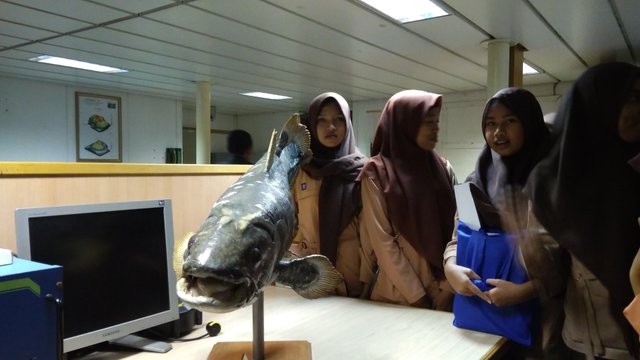Coelacanth, Ancient Fish Remaining
Have you seen the original form of ancient fish that by the evolutionists are considered as the ancestors of modern fish and has been declared vanished from the face of the earth since 70 million years ago If not, try to stop at the Zoology Building, Research Center for Biology LIPI Cibinong, Kab. Bogor. There we can witness the specimens of ancient fish thought to have existed since the Devonian era 400 million years ago. That means 200 million years more ancient than the age of new dinosaurs appearing on earth in the Triassic era. The ancient fish was known by the name coelacanth.

Sea king
The name coelacanth comes from the Greek words coelia (hollow) and acanthos (thorns), which means fish with hollow thorns. Based on historical records, the first coelacanth fish was caught scientifically on December 23, 1938, when Captain Hendrick Goosen got it from the Indian Ocean, not far from the mouth of the Chalumna river. By Marjorie Courtenay-Latimer a curator of museums in East London, South Africa the fish was handed over to a fish expert from Rhodes University, Prof. J.L.B. Smith. To honor Latimer and Smith's services, the ancient fish was later named Latimeria chalumnae Smith.
Search locations where the ancient fish lived for the next dozen years and then get the waters of the Comoros Islands, west of Madagascar, as a habitat. That's where several hundred individuals are estimated to live at sea depths of more than 150 m. Outside the archipelago, until the 1990s some individuals were also caught in the waters of Mozambique, Madagascar, and South Africa. However, they are still considered part of a population more or less the same as those on the Comoros Islands.
In 1998 or sixty years since the first discovery, a coelacanth fish was caught fishing nets in the waters of Manado Tua, North Sulawesi. This fish has been long known by the local fishermen, but not yet known to exist by the world of science. The fish that the fisherman called the king of the sea was then sent to an American researcher living in Manado, Mark Edmann. Together with two colleagues, R.L. Caldwell and Moh. Kasim Moosa of LIPI, Mark published his findings in the science magazine Nature, 1998.
Different types
Initially, scientists thought the coelacanth found in the waters of North Sulawesi was similar to the coelacanth (Latimeria chalumnae Smith) found in the Comoros Islands. But later, based on DNA-mitochondrial analysis and population isolation, although still one order, the two fish are different. Some Indonesian and French researchers then proposed the sea king fish from Manado as a new species with the scientific name Latimeria menadoensis. The specimen is now stored in the Museum of Zoology, Research Center for Biology LIPI Cibinong.
Two years later also found a group of coelacanth living in the waters of Marine Protected Areas (St.). Lucia in South Africa. People then realize that there are possibilities for other coelacanth populations in the world, as well as in other parts of the archipelago, given that these fish live isolated in the depths of the sea, especially around the volcanic islands.
According to Ika Rachmatika S., et al., From LIPI Biology Research Center, there are several morphological and genetic characters that distinguish between Latimeria chalumnae from Komoro Island and Latimeria menadoensis from Manado. Latimeria chalumnae is bluish in color with irregular white stains on the scales, while Latimeria menadoensis is brownish with irregular white stains on the scales. In addition, there are differences in meristic characters. Latimeria menadoensis has a smaller number of fingers on the second dorsal fin, but has an additional number of additional caudal fins. Overall, of 23 characteristic meristics and morphometrics observed, approximately 52 percent of which are different.
In terms of genetics, seen from the DNA arrangement of two segments of the mitochondria (which encode cytochrome b and 12 S ribosomes (RNA) there is a mutation or mutation substitution of 4.85 percent (transisitransversion 13: 1) and 2.85 percent ( transition-tranversion 2, 4: 1) on the base structure By using a 2 percent per liter nukletid per million year substitution rate for cytochrome b DNA, and 1 percent per million years for 12 S rRNA DNA, it is known that L. chalumnae and L. menadoensis have about 1,220,000 years old (DNA that encodes cytochrome b) and 1,420,000 years (DNA that binds 12 S rRNAs) from their ancestors.This data suggests that Latimeria fish populations in Comoro and Sulawesi Islands are of two different types, but both are still closely related.
Fossil fish
Coelacanth fish belong to the order of Coelacanthiformes. Based on the fossil, it first appeared on earth in the Devonian era (about 400 million years ago). In addition to Latimeria chalumnae and Latimeria menadoensis, all members of the Coelacanthiformes have become extinct and leave only fossils. Even before Latimeria chalumnae was found in Kep. Comoros on December 23, 1938, species of coelacanth fish had been estimated extinct at the end of the Cretaceous Period about 65-70 million years ago. Therefore, since it was first discovered live coelacanth fish, the fish was also called fossil fish.

This fish has a uniqueness that is not shared by other types like the seven fins lobbing meat, additional fins on its tail fin, intracucranial connection at the top of its head, and the presence of cartilage containing fluid as a buffer of its body called notokorda. In addition, the position of the anus and its reproductive tract are right in the middle of its two abdominal flaws that appear to be at the center of the base of both feet as commonly in humans.
Given the flesh-lined fins that resemble hand and foot bulges, coelacanth fish are assumed to be closer to four-legged animals (tetrapods) and to lungfish than to the common types of fish we see. The fish we usually see or Teleostei group of ancient fish called Paleoniscoids are abundant in the Carbon era until the beginning of Triassic (approximately 100 million years ago).
Unique behavior
The types of Latimeria are known to live at a depth between 150-2000 m with temperatures around 18o C. This species likes volcanic and lava slopes. During the day these fish prefer to live in the cave in small groups (up to 14 tails). In the evening this fish will come out following the direction of the current to find food. Latimeria belong to predatory fish; the food is small fish that live in the base and the middle column. This also corresponds to the structure of the gastrointestinal tract that has a thick and thick-walled bowel and intestine.
Despite the nickname of the king of the sea and the look of a fierce, coelacanth fish tend to be lazy. Perhaps because of his sturdy body shape, his swimming motion was slow. Despite having fins with a fleshy bulge that resembles hands and feet, these fish can not run on the bottom of the waters as imagined. But when swimming, both pairs of abdominal fins and chest show a movement like a horse racing that runs slowly. In addition, it is known Latimeria fish sometimes menunggingkan body to the bottom of the water vertically with the muzzle touched the bottom of the water. In this position the tail fin will move or rotate in a right angle to its body.

Latimeria belongs to fish that experienced the making in the body and gave birth to a child. This breeding pattern is different from the types of fish in general who do fertilization outside the body. Although fertilization and development of eggs occur within the reproductive tract, the developing eggs do not get the direct feeding from the mother as well as in mammals (mammals). The eggs produced as in Latimeria chalumnae are small (at most 26 grains) and stored in the reproductive tract or oviduct. After being fertilized it takes a long time (about a year) to develop into a ready-to-be-born pupil. The low reproductive potential and limited distribution make this fish in conservation status threatened with extinction.
oh..
Downvoting a post can decrease pending rewards and make it less visible. Common reasons:
Submit
It is important for understanding the history of science, especially about ancient animals
Downvoting a post can decrease pending rewards and make it less visible. Common reasons:
Submit
i know, but i dont realy get the point ahaha
Downvoting a post can decrease pending rewards and make it less visible. Common reasons:
Submit
Wkwkwkk
Downvoting a post can decrease pending rewards and make it less visible. Common reasons:
Submit